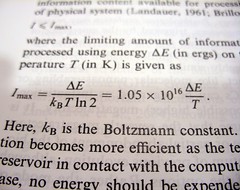September 23, 2009
The hot limits to growth
 Over at Overcoming Bias Robin is making the argument that economic growth will eventually be limited: even by expanding at lightspeed the amount of amount of matter we can turn into something valuable will only grow as the cube of time, but any positive exponential economic growth rate will outrun this sooner or later. Others are not so convinced, arguing that the value is not strictly tied to matter but by patterns of matter, possibly making it possible to have an exponential growth of value even when matter doesn't accumulate fast enough.
Over at Overcoming Bias Robin is making the argument that economic growth will eventually be limited: even by expanding at lightspeed the amount of amount of matter we can turn into something valuable will only grow as the cube of time, but any positive exponential economic growth rate will outrun this sooner or later. Others are not so convinced, arguing that the value is not strictly tied to matter but by patterns of matter, possibly making it possible to have an exponential growth of value even when matter doesn't accumulate fast enough.
This got me thinking of the thermodynamic problems of an expanding supercivilization, trying to turn cosmic matter into something carrying value.
A civilization expanding at velocity v controls a spherical volume V = 4pi(vt)^3/3 at time t, containing M = rho V units of mass. Either information is encoded in matter, in which case the maximal amount of information I the civilization can have is Imax = kM = (4 pi k rho/3) v^3 t^3 (the "classical case") or it is bounded by the Bekenstein quantum gravity bound, giving I = kMR = (4 pi k rho/3) v^4 t^4 (the "quantum case").
 Expanding means that it takes disorganized matter and turns part or all of it into information storage. Disregarding any energy cost of doing this there is still an entropy cost that has to be paid due to the Brillouin inequality: every bit of matter has to be set to a certain value, erasing at least one bit of information. This produces an energy cost of P = kb T ln(2) I' that has to be dissipated as waste heat. In the classical case P = [4 pi k rho kb T ln(2)] v^3 t^2 and in the quantum case P = [16 pi k rho kb T ln(2) / 3] v^4 t^3.
Expanding means that it takes disorganized matter and turns part or all of it into information storage. Disregarding any energy cost of doing this there is still an entropy cost that has to be paid due to the Brillouin inequality: every bit of matter has to be set to a certain value, erasing at least one bit of information. This produces an energy cost of P = kb T ln(2) I' that has to be dissipated as waste heat. In the classical case P = [4 pi k rho kb T ln(2)] v^3 t^2 and in the quantum case P = [16 pi k rho kb T ln(2) / 3] v^4 t^3.
(Note that I assume the civilization does not incur any thermodynamic operating costs. It runs all its computations as environment-friendly reversible computations etc.)
This waste heat has to be radiated away somewhere. Plugging this into Stephan-Boltzmann's law gives P = 4 pi sigma T^4 v^2 t^2. In the classical case this gives T = {[k rho kb ln(2) / sigma] v}^(1/3). The temperature of the civilization grows as the cube root of the expansion velocity. The quantum case on the other hand produces T = {[4 k rho kb ln(2) / 3 sigma] v^2 t}^(1/3) Here the temperature rises with the cube root of time and the 2/3rd power of velocity: the civilization will have to slow down to avoid overheating just from its own expansion.
 Plugging in numbers, the constant in the brackets in the quantum case is 8.5*10^8 K^3 s / m^2. For lightspeed expansion this produces a temperature growing as 4.25*10^8 t^(1/3) - it would look like a supernova. Not terribly likely. Assuming that the civilization wants to keep a temperature of a few (lets say 100) Kelvin instead (allowing me to ignore cosmic background radiation) gives an expansion rate of v = 0.0343/sqrt(t) m/s. That civilization will creep forward at a literal snails pace - the entropic cost of converting matter into the maximal information density is simply astronomical.
Plugging in numbers, the constant in the brackets in the quantum case is 8.5*10^8 K^3 s / m^2. For lightspeed expansion this produces a temperature growing as 4.25*10^8 t^(1/3) - it would look like a supernova. Not terribly likely. Assuming that the civilization wants to keep a temperature of a few (lets say 100) Kelvin instead (allowing me to ignore cosmic background radiation) gives an expansion rate of v = 0.0343/sqrt(t) m/s. That civilization will creep forward at a literal snails pace - the entropic cost of converting matter into the maximal information density is simply astronomical.
Ok, what about the classical civilization? Let's assume that it stores one bit per hydrogen atom mass, making k 6*10^26 bits/kg. That gives a temperature of 0.00246 v^(1/3) K. For lightspeed expansion I get a mere 1.6479 K - so little that cosmic background radiation clearly overshadows it (and a more complex radiation model is needed).
The moral seems to be that ordinary supercivilizations can expand at a brisk pace, but civilizations near the limits of quantum gravity are terribly constrained by the laws of thermodynamics. Not to mention that if they mess up, their dense information storage and processors could of course implode into black holes. Speaking of which, this is probably how such a civilization would actually cool itself. Just create sufficiently big holes to have a very low Hawking temperature, and dump your entropy in there (a Wei Dai inverse Dyson sphere).
 Of course, if the civilization actually dissipates energy inside its volume it is in more thermodynamic trouble. This is likely, since it seems unlikely that *all* processes an advanced civilization would engage in are perfectly reversible. Error correction of bits that flip due to thermal noise or other causes requires paying entropic costs, and even communication and sensing have entropy costs.
Of course, if the civilization actually dissipates energy inside its volume it is in more thermodynamic trouble. This is likely, since it seems unlikely that *all* processes an advanced civilization would engage in are perfectly reversible. Error correction of bits that flip due to thermal noise or other causes requires paying entropic costs, and even communication and sensing have entropy costs.
But while the civilization volume grows as the cube of time (and hence the amount in need of dissipation) the area grows as the square of time - the amount of cooling area per cubic meter of civilization is decreasing as 1/t. The civilization either has to heat up (more bit errors to fix), slow down its activity or use black hole cooling.
Posted by Anders3 at September 23, 2009 10:50 PM